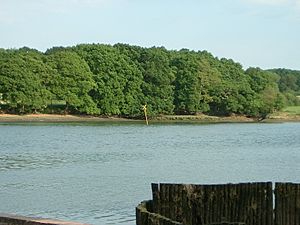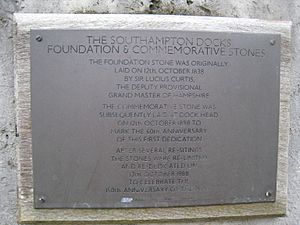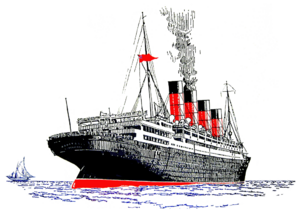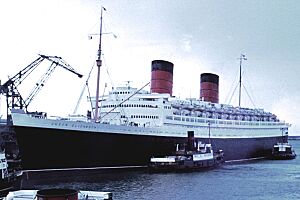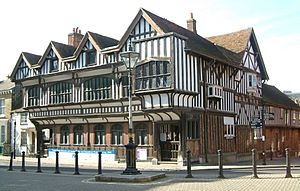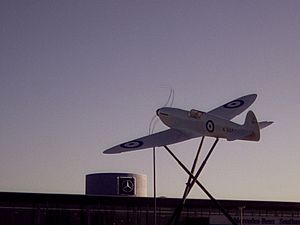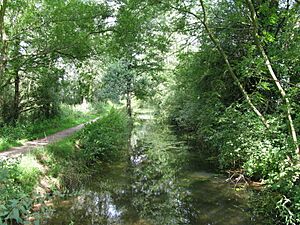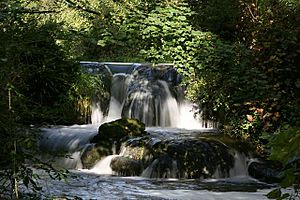History of the Port of Southampton facts for kids
Quick facts for kids History of the Port of Southampton |
|
|---|---|
| Location | |
| Country | United Kingdom |
| Location | Southampton, Hampshire, England |
| Coordinates | 50°53′47″N 1°23′48″W / 50.8965°N 1.3968°W |
| Details | |
| Operated by | Associated British Ports (ABP) |
| Available berths | 45 (20–207) |
| Website ABP |
|
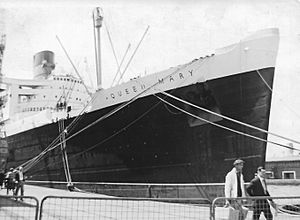
The Port of Southampton is a very important port on the south coast of England. It has been a busy place for ships and trade for nearly 2,000 years, ever since the Romans were in Britain.
Over the centuries, Southampton has been a key spot for building navy ships and for soldiers leaving for wars. It also played a big part in developing cool inventions like hovercraft, flying boats, and the famous Spitfire fighter plane. Before people traveled by jet planes, Southampton was Britain's main way to connect with the rest of the world.
Contents
A Quick Look at History
People have lived in the Southampton area since the Stone Age. But we don't have proof of boats or port activities from that far back. The Romans set up a settlement called Clausentum (now Bitterne Manor) around 70 AD. They had a busy port there, serving big towns like Winchester and Salisbury. The Romans left Britain in 407 AD, and the port was abandoned.
Around 700 AD, the Saxons started a new town called Hamwick (later Hamtun) across the River Itchen. It grew to about 5,000 people, which was a large town back then! The port traded with France, Greece, and the Middle East. They sent out wool and brought in wines and fancy pottery.
There's a famous story about Viking King Cnut the Great (also known as King Canute) in Southampton. He supposedly sat on the shore and told the incoming tide to stop. Of course, the tide didn't listen! He wasn't trying to show he was all-powerful. Instead, he was teaching his friends that even a king isn't all-powerful, and they should worship God. King Canute was crowned King of England in Southampton in 1016. His rule was peaceful. A large floating crane at the port, HLV Canute, is named after him.
The Saxon town became less important in the 900s because of Viking raids and the river getting too shallow. But a new town, also called Hamtun, grew up nearby in the Middle Ages. After the Norman Conquest, many French people moved in, creating English and French areas in the town. Wine and wool were still the most important things traded.
Southampton also became a place for building ships, especially for the Hundred Years' War. One famous ship was HMS Grace Dieu, King Henry V's main ship. It was built in 1418 and was huge, over 200 feet long! Sadly, it was destroyed by fire in 1439. Trade with Genoa and Venice also started, bringing in luxury items like perfumes, spices, and silk.
Southampton became one of England's most important ports, after London and Bristol. It was called Southampton to avoid confusion with another Hamtun, which became Northampton.
In 1620, the Pilgrim Fathers left Southampton for North America on the ships Mayflower and Speedwell. The Speedwell had problems and couldn't make the trip, so everyone transferred to the Mayflower, which sailed alone.
The 1500s and 1600s were a quiet time for Southampton. Other ports, like London, became more popular. For a while, Southampton was better known as a fancy spa town and a place for sea-bathing than as a port.
The Modern Era
Trade slowly picked up again. The port handled wine and fruit from Spain and Portugal, grain from Ireland, and coal from Newcastle. Paddle steamers started carrying passengers to the Channel Islands and Le Havre in 1823. They used Watergate Quay, but only at high tide. The first Royal Victoria Pier opened in 1833, allowing ships to dock at any tide.
When the railway to London opened in 1840, the port really took off. So many ships arrived that the town's docks couldn't handle them all. The first new dock opened in 1843, followed by a second in 1851. More berths were added between 1875 and 1902. In 1890, Queen Victoria opened the Empress Dock, which was bigger and deeper. Several dry docks for ship repairs were also built.
Big shipping companies started using Southampton. P&O began service in 1840. Others followed, connecting Southampton to South America, South Africa, and across the Atlantic. The White Star Line (famous for the Titanic) moved from Liverpool to Southampton in 1907, and Cunard followed in 1919.
A huge new dock, the Eastern Docks system, opened in 1911. It was first called the White Star Dock, but later became Ocean Dock. In 1892, the Royal Pier reopened, now made of iron. The London and South Western Railway company took over the docks in 1892.
Many new ships were too big for the existing dry docks. So, a fifth, and then a sixth, even larger dry dock was built. When ships got even bigger, a massive floating dry dock was brought in from Newcastle in 1924. It was the largest in the world! This dock could be filled with water to sink it, a ship would sail in, and then the water would be pumped out to lift the ship for repairs. It could handle large ships like the RMS Aquitania. This floating dock was later sold and sank on its way to Brazil.
The "New Docks" opened in 1934. This was a huge quay (a long platform for ships) and a lot of new land created by filling in water. The seventh dry dock, the King George V Graving Dock, opened here in 1933. The New Docks could fit the giant ships like the Queen Mary and the RMS Queen Elizabeth. Today, these are called the Western Docks. A container port was built here between 1969 and 1997 to handle the growing use of shipping containers.
At the Ocean Dock, the beautiful Art Deco Ocean Terminal opened in 1950. It was a fancy building for passengers of the big Atlantic liners. It had waiting rooms, baggage areas, shops, and even special rooms for journalists. It was a very luxurious place for its time. The Ocean Terminal was taken down in 1983. The Queen Elizabeth II passenger terminal opened in 1966 and is still used today. A new Ocean Terminal opened in 2009.
The time between the two World Wars was very busy for the port. It was called the "Gateway to the Empire." In 1936, Southampton handled almost half of all the UK's ocean-going passenger traffic.
Here are some facts from 1938:
- Passengers: 560,000
- Cruise passengers: 70,000
- Shipping: 18.5 million tons
- Shipping lines: 32
- World ports served: 160
Southampton also handled a lot of cargo. For example, nearly 90% of South Africa's fruit exports to the UK came through Southampton. Special freight trains meant that fruit arriving in Southampton in the morning could be sold in London by the afternoon!
Museums of Southampton
To mark 100 years since the Titanic sailed, a big new exhibition called "Southampton’s Titanic Story" opened in April 2012. It's part of the new SeaCity Museum in the city center. This museum also has a permanent exhibition called "Gateway to the World."
These museums use old city buildings that are important for history. For example, the SeaCity Museum uses the former Magistrates' Courts.
Southampton's archaeology museum is inside a city wall built in 1417 as a fort. It was later used as a prison and called God's House Tower. The museum has galleries about Roman, Saxon, and medieval times. Next to it is the Southampton Old Bowling Green, the world's oldest, dating back to 1299.
Near the city wall, you can see a replica of a wide cargo boat used for shipping wine and wool in the 1300s. It's built into the ground, showing how the port grew on reclaimed land. There's also a replica of a similar boat being built, showing old construction methods.
The Medieval Merchant's House, built in 1290, was the home and business of a wine merchant. It shows what homes looked like back then. Tudor House Museum is a large, striking 15th-century timber-framed house. It's considered the city's most important historic building and reopened in 2011 after being renovated.
Flying Boats and Seaplanes
Flying boats carried passengers and mail from Southampton between 1919 and 1958. Back then, long runways for big planes were rare, and plane engines weren't as reliable. If an engine failed, it was safer to land on water!
The first service in 1919 flew from the Royal Pier to nearby towns. In the 1920s, flights went to Northern France. As technology got better, Imperial Airways started services to Africa and the United States in 1937. Later, flights went to places like Australia, Tokyo, and Hong Kong.
During World War II, flying boat services were moved to Poole Harbour for safety. After the war, services continued from Southampton until 1958. You can see a Short Sandringham flying boat at the Solent Sky museum.
The Supermarine factory in Woolston was famous for its success in the Schneider Trophy races, winning three times in a row. Because of his experience with seaplanes, Reginald J. Mitchell became the chief designer of the Supermarine Spitfire fighter plane, which was very important in World War II. You can also see a Spitfire at the Solent Sky museum.
Military Southampton
Southampton has a long history as a place where soldiers left for war, going all the way back to King Henry V's departure for Agincourt in 1415. The port has been very involved in most of Britain's wars.
The Marchwood Military Port, built in 1943, is a base for the army and home to several Royal Fleet Auxiliary ships. It's the only place in the country that can load all military vehicles onto ships going to war zones. The port played a huge role in sending ships with equipment during the 1982 Falklands conflict. Two of Southampton's most famous passenger ships, the Cunard Line RMS Queen Elizabeth 2 and the P&O liner SS Canberra, also helped in the Falklands War.
In the Middle Ages, naval warships were built in the Watergate Quay area. Later, naval and merchant ships were built in the Redbridge area. From 1904 to 2004, the John I. Thornycroft shipyard in Woolston built warships for the Royal Navy. This company was especially busy during the two World Wars.
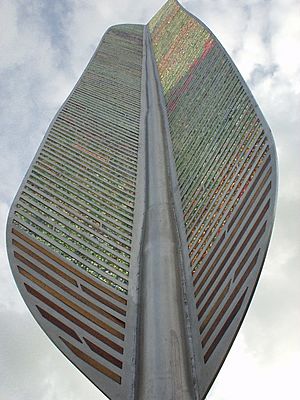
Some types of ships built in Woolston include:
- Coastal Motor Boat
- Thornycroft type destroyer leader
- Thornycroft M-class destroyer
- Type IV Hunt-class destroyer
- Landing Craft Assault
Cross-Channel Ferries
Passenger steamers used to travel from Southampton to places like Le Havre, Cherbourg, and the Channel Islands. Most passengers arrived at the docks by train.
In the 1960s, port operators realized people wanted to take their cars on ferries. So, passenger-only services stopped in 1964. The first roll-on/roll-off car ferry service began, with ships like Viking I and Viking II going to Le Havre and Cherbourg. By the early 1970s, these ships were replaced by larger ones. However, by 1984, all passenger ferry services from Southampton had either stopped or moved to nearby Portsmouth.
In 1991, Stena Sealink restarted a service to Cherbourg. But this service also stopped in 1996 due to less demand and the opening of the Channel Tunnel.
Today, there are no cross-channel ferries from Southampton. Most services now run from Portsmouth, which is about 20 miles east. Poole, 30 miles west, also has some services.
The old ferry dock in Southampton became the Ocean Village development. It's now a marina for yachts, with homes, shops, restaurants, and a cinema. It has also hosted major yacht races, like the Whitbread Round the World Race.
The National Oceanography Centre opened south of this area in 1996. It's a big center for marine science and part of the University of Southampton. It's also the base for ocean research ships like RRS Discovery.
Cross-Solent Hovercraft
In July 1966, British Rail Hovercraft started a Seaspeed hovercraft service between Cowes and Southampton. They used two SR.N6 hovercraft. These crafts were later made longer to carry more passengers. The service was taken over by Hovertravel in 1976 and stopped at the end of 1980.
Later, in 1981, Red Funnel used different types of hovercraft called HM2 Mk III SES crafts. These were mainly for transporting workers.
In May 1990, the Cowes Express company started a new service from Southampton Town Quay to Cowes. They used faster ships called Cirrus 120P surface effect ships, which could carry up to 330 passengers at high speeds. These ships were quieter than traditional hovercraft. However, the service ended in 1992.
Southampton's Canals
Andover Canal
A 22-mile-long canal linked Redbridge (at the western end of the port) with Romsey, Stockbridge, and Andover from 1790 to 1859. It was later filled in, and a railway was built over much of it. Parts of the canal and railway can still be seen today.
Salisbury and Southampton Canal
Another canal was planned to connect Southampton with Salisbury. It used part of the Andover canal. The eastern section of this canal started in Redbridge and followed the River Test.
People back then wondered why they built a canal so close to a river that ships could already use. A poet even made fun of it! But there were reasons:
- The River Test estuary was shallow and muddy back then, making it hard for ships. It was only later, when the New Docks were built, that it was dredged to be deep.
- Different types of boats were needed for rivers and canals.
- The canal allowed boats to load and unload anywhere, which was important in the city. It also offered better protection from bad weather.
- The people who built it hoped it would be part of a bigger network of canals, but that never happened.
This canal wasn't very successful. It had many problems and was never fully open. It was filled in between 1820 and 1851. Many people in Southampton today don't even know about the city's canal history, except for a few street names like Canal Walk.
From the River Itchen at Woodmill Bridge, a river route goes to Winchester, about nine miles upstream. Winchester was once the nation's capital, partly because of its link to the sea. The Itchen Navigation was a canal system that helped boats get around difficult parts of the river. It was open from 1710 to 1869 for moving farm products and coal. There's now a project to help preserve this old canal.
Images for kids


